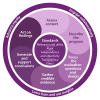CDC Program Evaluation Framework, 2024
- PMID: 39316770
- PMCID: PMC11444645
- DOI: 10.15585/mmwr.rr7306a1
CDC Program Evaluation Framework, 2024
Abstract
Program evaluation is a critical tool for understanding and improving organizational activities and systems. This report updates the 1999 CDC Framework for Program Evaluation in Public Health (CDC. Framework for program evaluation in public health. MMWR Recomm Rep 1999;48[No. RR-11];1-40) by integrating major advancements in the fields of evaluation and public health, lessons learned from practical applications of the original framework, and current Federal agency policies and practices. A practical, nonprescriptive tool, the updated 2024 framework is designed to summarize and organize essential elements of program evaluation, and can be applied at any level from individual programs to broader systems by novices and experts for planning and implementing an evaluation. Although many of the key aspects from the 1999 framework remain, certain key differences exist. For example, this updated framework also includes six steps that describe the general process of evaluation planning and implementation, but some content and step names have changed (e.g., the first step has been renamed Assess context). The standards for high-quality evaluation remain central to the framework, although they have been updated to the five Federal evaluation standards. The most substantial change from the 1999 framework is the addition of three cross-cutting actions that are core tenets to incorporate within each evaluation step: engage collaboratively, advance equity, and learn from and use insights. The 2024 framework provides a guide for designing and conducting evaluation across many topics within and outside of public health that anyone involved in program evaluation efforts can use alone or in conjunction with other evaluation approaches, tools, or methods to build evidence, understand programs, and refine evidence-based decision-making to improve all program outcomes.
Conflict of interest statement
All authors have completed and submitted the ICMJE form for disclosure of potential conflicts of interest. Leslie A. Fierro reported payment for work on this project as an independent consultant under a subcontract arrangement with the prime contractor GINTECH, LLC. No other potential conflicts of interest were disclosed.
Figures



References
-
- de Beaumont Foundation, Public Health National Center for Innovations. Defining public health practice: 25 years of the 10 essential public health services. Alexandria, VA: Public Health Accreditation Board; 2020. https://phaboard.org/wp-content/uploads/Defining-Public-Health-Practice-...
-
- Foundations for Evidence-Based Policymaking Act of 2018. 115th Congress. Pub. L. No. 115–435. Washington, DC: US Government Publishing Office; 2019. https://www.congress.gov/bill/115th-congress/house-bill/4174/text
-
- Office of Management and Budget. M-19–23. Memorandum on phase 1 implementation of the Foundations for Evidence-Based Policymaking Act of 2018: learning agendas, personnel, and planning guidance. Washington, DC: Office of Management and Budget; 2019. https://www.whitehouse.gov/wp-content/uploads/2019/07/M-19-23.pdf
-
- Office of Management and Budget. M-21–27. Memorandum on evidence-based policymaking: learning agendas and annual evaluation plans. Washington, DC: Office of Management and Budget; 2021. https://www.whitehouse.gov/wp-content/uploads/2021/06/M-21-27.pdf
-
- Mark MM, Henry GT, Julnes G. Evaluation: an integrated framework for understanding, guiding, and improving policies and programs. San Francisco, CA: Jossey-Bass; 2000.
MeSH terms
LinkOut - more resources
Full Text Sources
